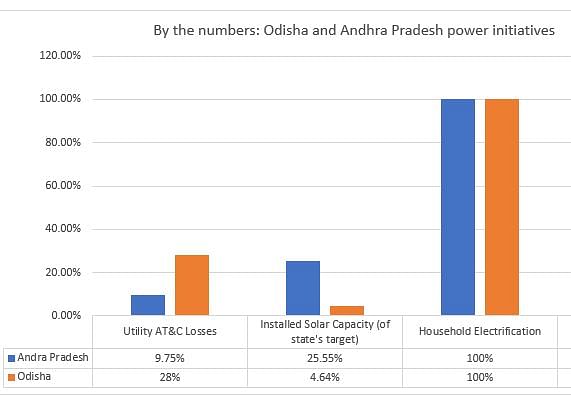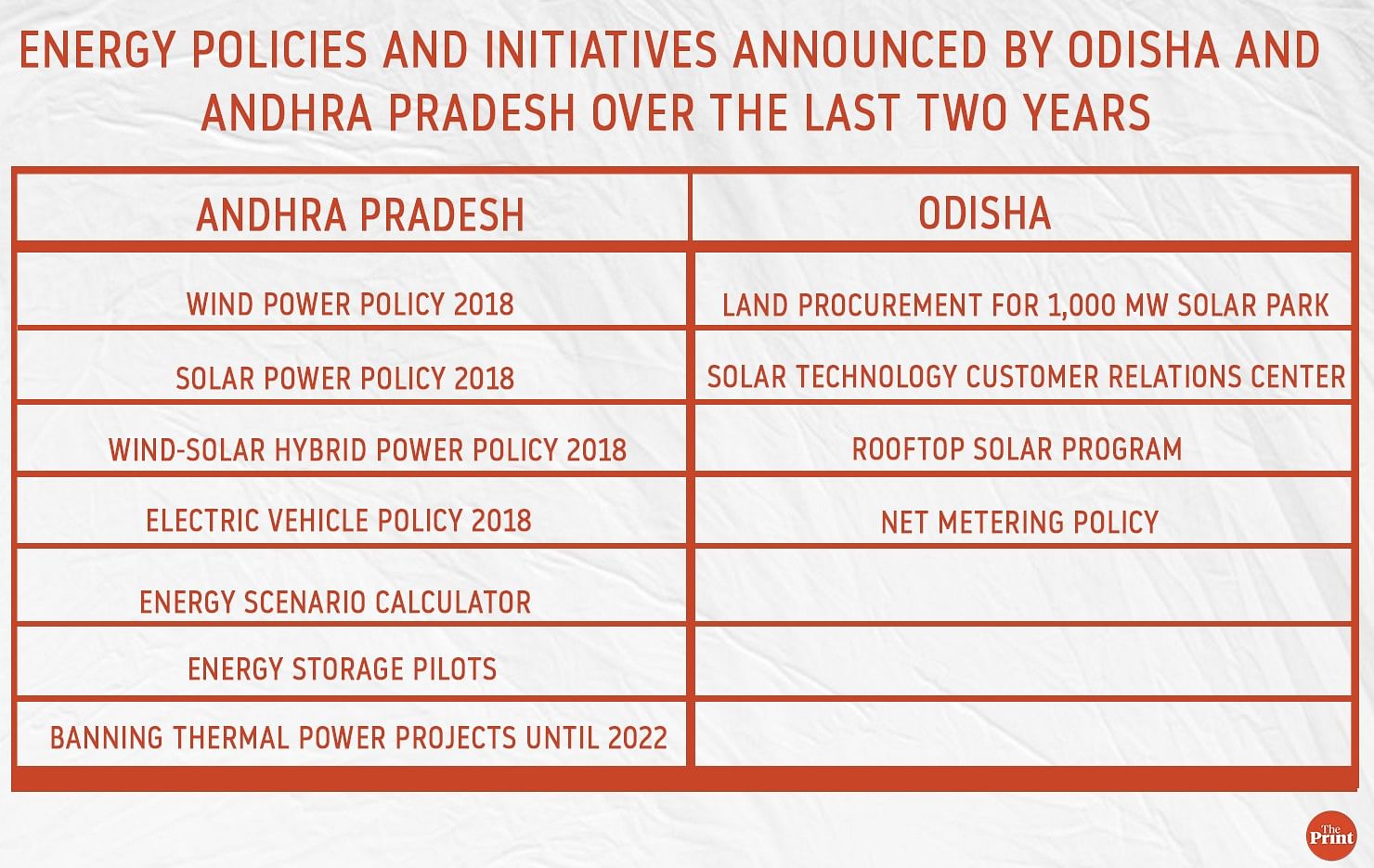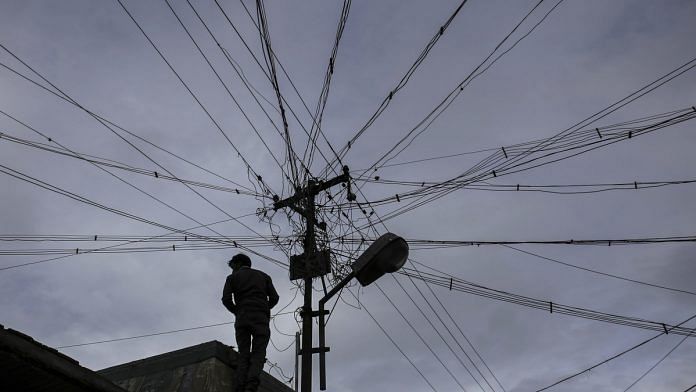For the Indian electorate, electricity has always been important– in terms of access, reliability and cost. In the lead up to this Lok Sabha election, lakhs of new consumers were connected to India’s electricity grid. While this accomplishment is laudable, the power sector remains deeply challenged.
State governments are trying to balance access and quality within the political constraints of maintaining extremely low consumer prices. Let’s take up the case of Andhra Pradesh and Odisha to demonstrate this further.
An analysis of the power sector in these states reveals that over the last two years these states have together enacted 23 significant new policies, reforms or initiatives to improve the state of their grids. However, Andhra Pradesh, perhaps as a result of being a recently bifurcated, and thereby new, state, has enacted more energy reforms and initiatives over the last two years than neighbouring Odisha.

Andhra Pradesh
Andhra Pradesh is an interesting case in this election cycle as it led by a first-term chief minister of a newly bifurcated region. The Seemandhra region of the erstwhile Andhra Pradesh was less-developed than the region that was turned into the state of Telangana. The new Andhra Pradesh state government faced the challenge of setting up new systems and infrastructure while having to create new policies for this region, separate from those that were established from Hyderabad, the former capital. Perhaps because of this blank slate, the Chandrababu Naidu-led government spent the last five years enacting several major power sector reforms and implementing new policies and initiatives to set the state on a path of energy security.
Also read: Poor electricity service quality plagues Modi’s Saubhagya scheme, but there are ways out
Utility initiatives
Notable reforms include the decision to participate in the central government’s utility reform programme, UDAY, to improve the performance of and stem the financial losses of the state-owned utilities. This has paid off by reducing the aggregate technical and commercial (AT&C) losses to 9.75 per cent, well below the 15 per cent target set by the central government.
Grid losses were further managed by an increased focus on efficiency in the state. The government partnered with Energy Efficiency Services Limited to deploy 22 million LED bulbs, 2.5 million LED-based street lights, and 1.5 million efficient agriculture pumps.
But with new connections increased the power demand and the need for better monitoring and management of bill collection for the utilities.
The average electricity service cost in Andhra Pradesh is still more than the revenue generated for the utilities (a gap of roughly Rs 0.24/unit). And while the state had increased tariffs in 2016 and 2017 (largely for industrial consumers), no new tariff increases are planned for 2019 -2020. To make it easier for customers to make payments, the state’s distribution companies commenced digital payment options for consumers in 2017.
In addition, last month the state government announced it would be working with EESL to deploy 1.7 million smart metres through state utilities. Smart metres are important for the utilities to be able to ensure regular, accurate cost recovery from customers with limited human intervention.
Also read: As Rs 412 billion piles up in electricity dues, India could implement prepaid system
Odisha
Odisha is led by four-term chief minister Naveen Patnaik, a real rarity in India today. The state has been one of India’s least-developed areas, but has made tremendous strides in improving the delivery of basic services and improving the livelihoods of its citizens over the last 20 years.
Not being a part of the Bharatiya Janata Party-led National Democratic Alliance coalition has meant that the state has not easily adopted all central government policies, choosing at times to instead craft its own state-specific projects.
Over the last two years, the state government has not enacted as many power sector reforms as Andhra Pradesh, but it was notably one of the first states in the country to engage the private sector in a big way by co-owning the major state power generation corporation with US-based AES Corp and privatising its state-owned utilities.

Utility initiatives
Odisha became a power surplus state in March 2019 when CM Patnaik threw the switch for two additional 1,320 MW power generation units. While the state has achieved 100 per cent household electrification, the state of the grid is not as robust as the power generation capacity in the state.
The administration never signed on to the central government’s UDAY programme (which was designed to assist state-owned utilities) and today the AT&C losses remain some of the highest in India with the Central Electricity Supply Utility having an AT&C loss of around 34 per cent (the combined average AT&C loss of the four utilities in the state brings this down to 28 per cent).
To regain control of the situation, the state did conduct an auction to re-privatise the utility, but the awards are yet to be announced. The other three utilities in the state were originally owned by Reliance Infrastructure but their licenses were revoked by the state electricity regulator in early 2015 due to lack of payments to the state power generator and sustained high technical and commercial losses.
Despite a request from the state-owned utilities, the government did not raise the electricity rates for a large share of domestic consumers.
However, the state has continually increased the rates for power purchased from captive power plants (the last increase in 2017 was 83 per cent above the rate in 2016). The move was denounced by the industry in the state, which set up these plants to ensure reliable electricity for their heavy industry needs.
Finally, of note on the power sector initiative side, Odisha has made strides to increase efficiency. By partnering with EESL, over 305,000 LED street lights and over 45 million LED bulbs have been deployed across the state. To further decrease the demand of the agriculture sector on the grid, the government announced a new 90 per cent subsidy to deploy 5,000 solar-powered irrigation pumps.
Also read: Modi’s Saubhagya scheme can create serious problems with electricity tariffs
Energising ambitions
Quality energy access is a fundamental requirement not only to improve people’s wellbeing but also to drive economic growth. The Indian central government can set a vision for energy policy, but the states are the final arbiters who bring the vision to life or improve upon it through their own measures.

As the electorate in these states head to the polls, they will judge the incumbent governments on tangible impacts including specifically the reliability and cost of the electrons powering their lives and their enterprises.
The author is the Deputy Director and Senior Fellow of the Wadhwani Chair in US-India Policy Studies and Senior Fellow of the Energy & National Security Program at the Center for Strategic & International Studies (CSIS) in Washington, D.C. Views are personal.




Orissa has a lot of catching up to do.